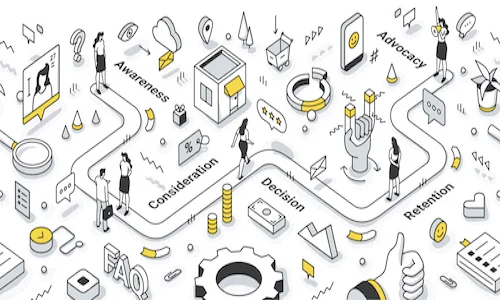
We live in a world where experiences matter, often more so than the actual product or service received. Why? Because experiences represent the holistic customer journey, encompassing every single touchpoint one has had with a company. This journey begins with the unaided awareness of sponsored advertising or an email in your spam folder, progresses to learning about the company and its offerings, and culminates in either loving or hating the experience.
What are the differences between B2C and B2B
We often read about the differences between B2C and B2B industries, particularly in terms of customer experience (CX). From the company’s perspective, the differences are indeed significant:
- The stakes in B2B are often higher than in B2C. The relationships are more complex, the sales cycles are longer, and the transactions are usually larger.
- The customer journey is often more complex, involving multiple touchpoints across different channels. This necessitates a more sophisticated approach to CX, focusing on seamless integration and consistency across all channels.
- The customer is not just one person, but often a team of decision-makers, each with their own expectations and needs. This means that the experience must be tailored to meet the needs of a diverse group of people, rather than just one individual.
- B2B customers often require a higher level of expertise and consultation than B2C customers.
- In the B2B world, the customer experience doesn’t end with the sale. B2B companies need to provide ongoing support and service to their customers, continually seeking ways to add value and deepen the relationship.
However, I see fewer differences in customers’ expectations of what should be delivered and how. Why? The answer is simple – when we conduct business in the B2B domain, we’re not dealing with an organisation, but with people. And people have expectations based on their day-to-day experiences. So, if one expects Amazon to know their name, and last purchase, and suggest a tailored shopping list, why wouldn’t they expect the same from the Airbus Group?
Speaking of great experiences…
Have you ever dined at a gourmet restaurant? If yes, you will understand my forthcoming sentiments, if not, allow me to share something with you – there is a unique magic about gourmet restaurants! Indeed – the food is delectable, the presentation is astounding, and the combination of taste palettes is awe-inspiring. Sounds magical, doesn’t it? But what truly enhances your dining experience is the ambience of the restaurant, the location, the exclusivity, the staff, and the special touch of having the chef visit your table (perhaps).

Imagine you’re launching a gourmet restaurant. You aspire to create an experience that will retain customers, encourage them to recommend you to others, and ultimately drive your business growth. To achieve this, you need to have the right ingredients, the correct recipes, and the perfect team to execute flawlessly.
Now, envision yourself as a multinational aluminium manufacturer. Your customers expect you to be a partner who can assist them in solving their problems and achieving their business objectives. And just like in a gourmet restaurant, in a B2B world customers anticipate superb experiences, and to provide them, you need to have:
The correct recipes – the vision, strategy and governance – to ensure that the experience is executed flawlessly.
The right ingredients – the data, technology, and processes – to construct products, services and experiences that will delight your customers.
And most importantly, you need the right people – a customer-centric culture and engaged employees – to create a memorable experience that keeps customers returning.
Recipes
When building your CX programme, it’s essential to establish a clear vision. To set a solid foundation for your CX transformation, it’s recommended to start with the end in mind. Based on recent Forrester Research, only 3 out of 10 CX teams are involved in designing the CX vision, CX strategy and CX governance. So, be proactive! Take the lead and define long-term CX goals, with a three-year strategy, and break them down into immediate objectives and intermediate steps towards success. Ensure that the experience design, CX measurement, and VoC initiatives are tightly woven together into a solid programme supporting every department in your organisation.
It's also important to assess your organisation's readiness, so evaluate your current data and technology processes (e.g. CRM, CS, VoC, and digital analytics) to identify existing capabilities and gaps. Outline their strengths and weaknesses.
Lastly, identifying key stakeholders across departments is crucial to ensure cross-collaboration and buy-in for CX as a company-wide mission.
Ingredients
Once you have the recipe in place, it’s time to find the right ingredients.
Collecting relevant insights is the first step towards getting CX right. Knowing how satisfied your customers are and whether they would return is quite useful. However, for the insights to be actionable, you need to ensure that you ask the right questions, to the right audience, at moments that matter. You also need to look beyond surveying. You’re sitting on a gold mine of unsolicited data, collected in multiple systems (e.g. CRM, call centre, customer communications) and in the digital space (e.g. social media, reviews, publications).
But what good is data that is analysed in isolation? Unified reporting will help you go beyond traditional metrics. It will help you add an additional layer of understanding of who your customers are, what they’re doing, and why they’re doing it. Mix together survey data, sentiment extracted from interactions with customer support agents, engagement statistics from your CRM data, and purchase and digital behaviour patterns. Then, stir well until finely mixed and pour into the relevant tools. And voila – just like that you have elevated from insights to actionable intelligence to making a real impact in your organisation.

With the right level of reporting, actions outlined and prioritisation, you can support teams across the entire organisation in developing better products, tailoring communication, offering the right solutions at the right time, or proactively reaching out to customers.
In essence, you’re providing the necessary intelligence for improving operational efficiency, optimising investment and increasing customer lifetime value.
While many stakeholders may think CX is an easy task, it’s actually not that simple, and we often turn to technology as an enabler and accelerator to help achieve the vision.
How can technology (or more precisely a Customer Experience Management platform) help? Work towards establishing an uninterrupted information flow – connect internal systems to ensure that full automation is possible, all valuable data is analysed, reported, and acted upon, and existing processes are enriched with data. Technology can indeed be the enabler and accelerator in achieving your vision. Yet, a third of B2B CX teams believe the organisations underinvest in Customer Data platforms. So, when choosing a technology vendor, there is no one-size-fits-all approach. It’s crucial to choose a vendor based on your objectives and long-term goals and ensure that their platform can facilitate your roadmap of activities and initiatives. The technology should complement and improve your internal processes, and not add an additional layer of complexity.
People
Last but certainly not least, great experiences cannot be achieved without a strong focus on your employees. Often, we undermine the impact and contribution that frontline staff could have – so listen to what your employees have to say! Take a sneak peek into a menu of improvement or new product ideas served by your employees. After all, they speak to customers daily.
But for your employees to be engaged, they should feel motivated, valued, and secure. Invest in their development, listen to their career aspirations, and invest in their well-being. Ensure that your culture is built around recognition, reinforcement, and reward. As a result, you will see higher engagement, better performance, and loyalty!
So, you’ve got the operational model of a successful gourmet restaurant. But remember, it takes time and a steep learning curve to master the skill of working at or establishing a gourmet restaurant. Setting up a CX strategy, and programme and ultimately achieving a culture-centric culture isn’t different! It takes time, consistency, and determination.

Effective Brand and Customer Experience Strategies for B2B Organizations
We are experts in guiding B2B organizations through the complexities of today’s experience economy. We work with companies in the manufacturing, technology, and service sectors, helping them overcome challenges in customer experience (CX) and brand positioning. Through our suite of solutions, including Advanced Analytics, Competitive Benchmarking, and CXM Platform services, we help organisations maintain strong relationships with their customers, stay ahead of the competition, and make data-driven decisions for sustainable growth.



